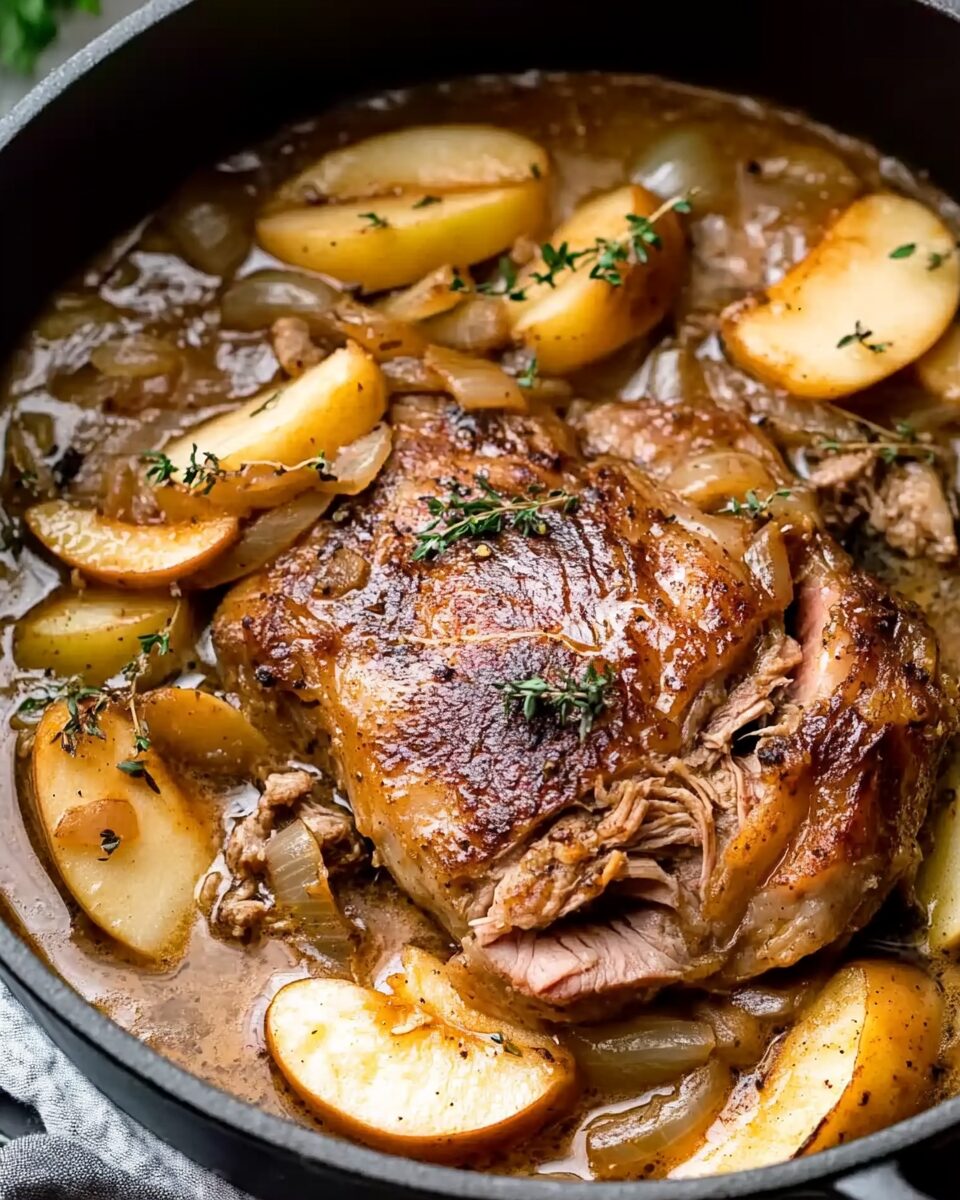Apple Cider Braised Pork Shoulder is a soul-warming one-pot dinner that’s perfect for cozy fall evenings. Tender pork is slow-cooked in a flavorful bath of apple cider, chicken broth, Dijon mustard, garlic, and herbs until it’s melt-in-your-mouth delicious. Finished with apples and onions for added sweetness and texture, this dish brings bold seasonal flavor and restaurant-quality comfort to your home kitchen. Serve it over mashed potatoes or egg noodles to soak up all the savory-sweet juices.
Full Recipe:
Ingredients
-
4–5 lb pork shoulder roast or Boston butt
-
2 tablespoons neutral oil
-
2 cups fresh apple cider (not apple cider vinegar)
-
2 cups chicken stock or broth
-
2 tablespoons Dijon mustard
-
1 tablespoon dehydrated minced onion
-
1 head garlic, top sliced off
-
3 rosemary sprigs
-
4 thyme sprigs
-
1 red onion, thickly sliced
-
2 firm tart apples (like Honeycrisp or Pink Lady), peeled and wedged
-
Kosher salt and freshly cracked black pepper
Directions
-
Preheat oven to 325°F (163°C).
-
Prepare the pork: Trim excess fat. If boneless, cut into 4 large chunks; if bone-in, cut into 2 large pieces. Pat dry and season generously with salt and pepper.
-
Sear: Heat oil in a large Dutch oven over medium-high. Sear pork 4–5 minutes per side until deeply browned. Work in batches if needed.
-
Mix braising liquid: Whisk together apple cider, chicken stock, Dijon, and dehydrated onion.
-
Assemble for braising: Return all pork to the pot. Pour in braising liquid. Add garlic head and tied herb bundle. Cover and bake for 3 hours, flipping pork halfway through.
-
Add apples and onions: Remove pot from oven, add apples and onions around pork. Cover and return to oven for 30–45 minutes, until pork is fork-tender.
-
Rest and serve: Let pork rest in juices for 30 minutes. Squeeze roasted garlic into the sauce, season to taste. Serve pork with braising liquid spooned over top.
Nutrients (Per Serving – Approx. 8 Servings)
-
Calories: 422 kcal
-
Carbohydrates: 22g
-
Protein: 39g
-
Fat: 19g
-
Saturated Fat: 5g
-
Cholesterol: 126mg
-
Sodium: 314mg
-
Potassium: 896mg
-
Fiber: 2g
-
Sugar: 16g
-
Vitamin A: 83 IU
-
Vitamin C: 8mg
-
Calcium: 48mg
-
Iron: 3mg
The Role of Apple Cider in Building Flavor
What makes this dish stand out is its use of real apple cider—not vinegar, but the unfiltered, slightly sweet, and tangy drink that’s a staple in autumn. Apple cider imparts natural sugars that caramelize over time and a subtle tartness that cuts through the pork’s richness.
The result is a sauce with both savory depth and fruity brightness, which perfectly complements the meat. Unlike sugary sauces that can feel cloying, apple cider braising allows the pork to absorb nuanced flavor as it slowly tenderizes, ensuring every bite is layered and balanced.
Why Pork Shoulder is the Ideal Cut for Braising
Pork shoulder—also known as Boston butt—is a beautifully marbled, collagen-rich cut that excels in low and slow cooking. The longer it cooks, the more the connective tissues break down, resulting in fork-tender meat that retains its juiciness without falling apart too soon.
It’s a forgiving cut, which means even novice home cooks can achieve amazing results. Braising it in apple cider and broth ensures it stays moist, flavorful, and satisfying without needing constant attention. Once it’s seared and in the oven, the heavy lifting is done by time and gentle heat.
Whether you’re using a boneless or bone-in roast, the meat develops a deep golden crust from searing, then transforms into succulent bites as it braises slowly with aromatics.
Aromatic Depth from Garlic, Mustard, and Herbs
Beyond the cider, what rounds out the flavor of this dish is a thoughtful selection of aromatics. Dijon mustard introduces tang and complexity without overpowering the palate. It complements the sweetness of the cider and sharpens the savory side of the braise.
Roasted garlic, used whole in this recipe, mellows during the slow cooking process and infuses the entire pot with a rich, buttery essence. Once softened, it’s squeezed into the sauce at the end, thickening the liquid and intensifying the umami.
Fresh herbs like rosemary and thyme bring woodsy notes that marry well with both pork and apples. When tied together and simmered gently, they release their oils into the braising liquid, creating a layered, aromatic profile that feels both rustic and elegant.
The Magic of Apples and Onions
Adding apples and onions toward the end of the cooking process ensures they retain just the right amount of structure and don’t dissolve into mush. Apples lend a sweet contrast to the pork, absorbing the surrounding juices and creating pockets of flavor that burst in your mouth.
Firm, tart apples like Honeycrisp or Pink Lady are ideal for this dish—they hold their shape while adding a vibrant counterbalance to the dish’s richness. Paired with thick slices of red onion, which become buttery and slightly sweet as they roast, the combination enhances the overall texture and flavor experience.
This interplay of savory and sweet brings harmony to the plate and keeps each bite interesting and dynamic.
Serving Suggestions: The Perfect Pairings
Apple Cider Braised Pork Shoulder shines brightest when paired with something that can soak up the savory-sweet sauce. Mashed potatoes are the classic companion, offering a creamy, neutral base that allows the pork and braising liquid to take center stage. Buttery egg noodles or even creamy polenta also work beautifully.
For a lighter twist, try it over cauliflower mash or roasted root vegetables. A side of sautéed greens like kale or Swiss chard adds a hint of bitterness that balances the sweetness of the sauce.
If you’re serving this dish for a gathering, consider offering crusty bread on the side—it’s perfect for sopping up every last drop of the golden sauce.
Meal Prep and Leftover Magic
One of the best aspects of this dish is its versatility with leftovers. Apple Cider Braised Pork Shoulder actually improves in flavor after a day or two as the meat continues to absorb the juices. Store it in an airtight container with plenty of braising liquid and reheat gently on the stove or in the oven.
Leftover pork can also be shredded and used in sandwiches, tacos, wraps, or even a savory pork hash with eggs the next morning. The sauce doubles as a flavorful base for soups or stews, giving you options beyond the initial meal.
This recipe is also freezer-friendly—just be sure to cool it completely before transferring it to a freezer-safe container. It will keep well for up to three months and can be reheated for a comforting, ready-made dinner down the line.
Nutritional Profile and Health Considerations
Despite its richness, this recipe offers a fairly balanced nutritional profile. Pork shoulder provides high-quality protein, essential vitamins like B12, and minerals such as zinc and iron. The apples and onions add fiber and natural antioxidants, while the use of broth and cider (rather than cream or butter) keeps the fat content in check.
For a leaner version, you can trim excess fat from the pork before cooking, or even substitute a leaner cut like pork loin, though it may not be quite as tender. Choosing low-sodium broth helps reduce overall salt levels, and the naturally sweet apples mean you don’t need to add sugar for flavor.
When to Make This Dish
Apple Cider Braised Pork Shoulder is the perfect choice for cool-weather dinners, Sunday family meals, or festive occasions where you want to offer comfort food with a gourmet edge. It’s easy enough for weeknights (with some planning ahead) but impressive enough to serve at holiday dinners or autumn dinner parties.
The presentation is rustic and warm, especially when served in the Dutch oven it was cooked in. Garnish with a few fresh rosemary sprigs or thin apple slices to elevate the visual appeal.
Conclusion
Apple Cider Braised Pork Shoulder is more than just a fall recipe—it’s a dish that speaks to the heart of home cooking. With its blend of sweet cider, aromatic herbs, tender pork, and caramelized apples, it offers both depth of flavor and simple comfort. Each element works together to create a warming, one-pot meal that feels indulgent yet rooted in tradition.
Whether you’re new to braising or a seasoned cook looking for a new seasonal favorite, this dish delivers. It’s a recipe that rewards patience with every juicy, tender bite—and one that you’ll return to every year as the leaves change and the evenings grow cool. Serve it with love, and it’s guaranteed to become a family favorite.






